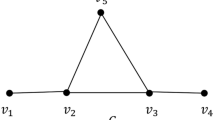Abstract
A Solovay function is an upper bound g for prefix-free Kolmogorov complexity K that is nontrivial in the sense that g agrees with K, up to some additive constant, on infinitely many places n. We obtain natural examples of computable Solovay functions by showing that for some constant c 0 and all computable functions t such that c 0 n≤t(n), the time-bounded version Kt of K is a Solovay function.
By unifying results of Bienvenu and Downey and of Miller, we show that a right-computable upper bound g of K is a Solovay function if and only if Ω g =∑2−g(n) is Martin-Löf random. We obtain as a corollary that the Martin-Löf randomness of the various variants of Chaitin’s Ω extends to the time-bounded case in so far as \(\Omega _{ \textnormal{K}^{t}}\) is Martin-Löf random for any t as above.
As a step in the direction of a characterization of K-triviality in terms of jump-traceability, we demonstrate that a set A is K-trivial if and only if A is O(g(n)−K(n))-jump traceable for all computable Solovay functions g. Furthermore, this equivalence remains true when the universal quantification over all computable Solovay functions in the second statement is restricted either to all functions of the form Kt for some function t as above or to a single function Kt of this form.
Finally, we investigate into the plain Kolmogorov complexity C and its time-bounded variant Ct of initial segments of computably enumerable sets. Our main theorem here asserts that every high c.e. Turing degree contains a c.e. set B such that for any computable function t there is a constant c t >0 such that for all m it holds that Ct(B↾m)≥c t ⋅m, whereas for any nonhigh c.e. set A there is a computable time bound t and a constant c such that for infinitely many m it holds that Ct(A↾m)≤logm+c. By similar methods it can be shown that any high degree contains a set B such that Ct(B↾m)≥+ m/4. The constructed sets B have low unbounded but high time-bounded Kolmogorov complexity, and accordingly we obtain an alternative proof of the result due to Juedes et al. (Theor. Comput. Sci. 132(1–2):37–70, 1994) that every high degree contains a strongly deep set.
Similar content being viewed by others
References
Barmpalias, G., Downey, R., Greenberg, N.: K-trivial degrees and the jump-traceability hierarchy. Proc. Am. Math. Soc. 137(6), 2099–2109 (2009)
Barzdin, J.: Complexity of programs to determine whether natural numbers not greater than n belong to a recursively enumerable set. Sov. Math. Dokl. 9, 1251–1254 (1968)
Bennett, C.H.: Logical depth and physical complexity. In: The Universal Turing Machine, 2nd edn. A Half-Century Survey, pp. 207–235. Springer, Berlin (1995)
Bienvenu, L., Downey, R.: Kolmogorov complexity and Solovay functions. In: Proceedings of the 26th International Symposium on Theoretical Aspects of Computer Science (STACS), pp. 147–158 (2009)
Cholak, P., Downey, R., Greenberg, N.: Strong jump-traceability I: the computably enumerable case. Adv. Math. 217(5), 2045–2074 (2008)
Downey, R., Greenberg, N.: Strong jump-traceability II: K-triviality. Israel J. Math. (2011). doi:10.1007/s11856-011-0217-z
Downey, R.G., Hirschfeldt, D.R.: Algorithmic Randomness and Complexity. Theory and Applications of Computability. Springer, New York (2010)
Hölzl, R., Kräling, T., Merkle, W.: Time-bounded Kolmogorov complexity and Solovay functions. In: Proceedings of the 34th International Symposium on Mathematical Foundations of Computer Science, pp. 392–402 (2009)
Juedes, D.W., Lathrop, J.I., Lutz, J.H.: Computational depth and reducibility. Theor. Comput. Sci. 132(1–2), 37–70 (1994)
Kummer, M.: Kolmogorov complexity and instance complexity of recursively enumerable sets. SIAM J. Comput. 25(6), 1123–1143 (1996)
Kučera, A., Slaman, T.A.: Randomness and recursive enumerability. SIAM J. Comput. 31(1), 199–211 (2001)
Li, M., Vitányi, P.: An Introduction to Kolmogorov Complexity and Its Applications. Springer, Berlin (2008)
Miller, J.S.: The K-degrees, low for K-degrees and weakly low for K-degrees. Notre Dame J. Form. Log. 50(4), 381–391 (2010)
Nies, A.: Computability and Randomness. Oxford University Press, London (2009)
Schnorr, C.P.: Process complexity and effective random tests. J. Comput. Syst. Sci. 7, 376–388 (1973)
Solovay, R.M.: Draft of paper (or series of papers) on Chaitin’s work. Unpublished notes (1975)
Author information
Authors and Affiliations
Corresponding author
Additional information
The first author has been supported by the German Science Foundation (DFG) under grant ME 1806/3-1 and by a Feodor Lynen postdoctoral research fellowship by the Alexander von Humboldt Foundation.
Rights and permissions
About this article
Cite this article
Hölzl, R., Kräling, T. & Merkle, W. Time-Bounded Kolmogorov Complexity and Solovay Functions. Theory Comput Syst 52, 80–94 (2013). https://doi.org/10.1007/s00224-012-9413-4
Published:
Issue Date:
DOI: https://doi.org/10.1007/s00224-012-9413-4




